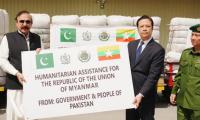ISLAMABAD: Pakistan’s textile industry, a key driver of the country’s exports and employment, is facing a crisis as high power costs, broken promises, and economic threats have pushed the sector to the brink, an industry body said.
The All Pakistan Textile Mills Association (APTMA) urged the government to intervene urgently and restore the competitive energy tariff of 9 cents per kilowatt-hour (KWh) that was promised to the industry but later withdrawn, leading to factory closures and job losses.
“The textile industry is in a critical situation due to high power costs, as the government’s failure to keep the promised rate of 9 cents per KWh and increase it to the current 14 cents has led to deindustrialization and export decline,” APTMA said in a presentation to the National Electric Power Regulatory Authority (NEPRA).
An APTMA representative said that power tariffs now exceed a critical threshold of 12.5 cents/KWh, which makes the industry uncompetitive and forces firms to shut down. Once rates go beyond 9 cents/kWh, the industry can't grow, and existing units decrease rapidly. If tariffs hit 1.5 times the Regionally Competitive Energy Tariff (RCET), firms become uncompetitive and shut down.
The current tariff, about 14 cents/kWh, signals a big decline for textile firms, posing a serious risk to Pakistan's economy. Urgent interventions are needed to prevent a major economic crisis, the All Pakistan Textile Mills Association (APTMA) made this plea before the National Electric Power Regulatory Authority (NEPRA).
Power consumption of textiles and apparel firms on the LESCO network saw a year-on-year decline of 49 percent in October 2023 and a 36 percent decline on MEPCO network, a clear indication of deindustrialization.
The representative of the Association said that Pakistan's textile sector faced a crisis as textile exports plummeted by 15 percent from $19.3 billion in FY22 to $16.5 billion in FY23 as the Regional Competitive Energy Tariff (RCET) of 9 cents was withdrawn. This follows a notable 54 percent increase in the two preceding years, from $12.5 billion in FY20 to an impressive $19.3 billion in FY22, putting the industry at a crucial juncture.
Even with a $5 billion boost to make things better and create jobs, the expected increase in export capacity by $5 billion and the creation of 0.3-0.5 million jobs don't seem to be happening as planned.
A shift toward high-value-added products and away from basic materials like yarn and grey cloth was in progress, but this positive trend took a hit in 2023. A 15 percent decline in textile exports was attributed to a larger economic crisis and the withdrawal of export-related tax benefits.
'Power Tariffs'
Hopes were pinned on power tariffs set at 9 cents per kilowatt-hour to energize the economy. However, the promised 51 percent surge in textile and apparel exports, generating an additional $9 billion compared to 2023, hasn't materialized. Plans to revive closed production units and reinstate around 8 million jobs now seem uncertain.
The envisioned establishment of 1000 new garment plants, creating 1 million jobs and increasing domestic value addition, hangs in the balance. The proposed shift away from using captive power, expected to reduce industrial gas consumption and boost grid usage by 3,000 megawatts, is currently just a vision.
'Profitability Woes'
Textiles and apparel businesses are grappling with financial challenges. Energy costs, constituting 12-18 percent of total input costs, were manageable at the prevailing 9 cents per kilowatt-hour tariff. But if the tariff increases to 14 cents, as suggested, the share of energy costs in total input costs would skyrocket to 23.33 percent, severely impacting profitability from 8.61 percent to a mere 1.0 percent, based on the 2022 financials of major textile exporters.
This profitability challenge, coupled with the nature of the textiles industry characterized by high volume and low margins, could force many firms to exit the sector. This would result in a significant loss of both export volume and value, posing a serious threat to the sustainability and viability of the textiles and apparel sector.
Unfulfilled Promises
Efforts to equalize costs by eliminating the cross-subsidy from power tariffs have fallen short. The proposed policy recommendations, including a specialized power tariff category and business-to-business contracts with wheeling charges, are yet to be effective.
Wheeling charges, typically applied in the energy sector, refer to the cost associated with transmitting electricity from a power generation source to the end-user through the existing electrical grid infrastructure. These charges cover the expenses related to the use, maintenance, and operation of the transmission system that facilitates the movement of electricity.
The envisioned Hybrid Bulk Power Consumers (BPCs) concept, intended to empower the export sector to develop its own power supply, is still on hold. These inefficiencies in government policies have hindered the industry's ability to compete globally.
Economic Impact
The potential exit of firms from the textiles and apparel sector carries severe implications for the overall economy.
The sector contributes a substantial 60 percent to export earnings, and its decline could lead to a reduction in export earnings, jeopardizing the ability to meet the import bill and external financing obligations.
This, in turn, could increase the need for external borrowing and heighten the risk of economic crises and sovereign default.
The anticipated reduction in GDP from the exit of these firms could potentially push the economy into a recession. This downturn would also reduce government revenue, limiting funds for development expenditures and necessitating increased government borrowing and debt servicing.
The exit of firms would cause a significant loss of employment, affecting the livelihoods of millions of households and potentially leading to increased demand for welfare spending. Spillover effects on related sectors like cotton and retail could result in losses of output, investment, and employment.
The power sector would also be impacted, with a reduction in industrial power consumption increasing costs for power producers and raising the tariff burden on residential and agricultural consumers. The recent decline in industrial power consumption by almost 50 percent on some networks is a clear sign of the challenges faced by the sector.
Regional Competitors
Regionally uncompetitive energy tariffs, combined with gas prices surpassing regional levels, make exports from Pakistan globally uncompetitive.
Power tariffs for Pakistan's exporters, burdened by a cross-subsidy to nonproductive sectors, are now double the average faced by competing firms in neighboring economies.
The looming threat of the European Union's Carbon Border Adjustment Mechanism (CBAM), operational by 2026 and covering textiles and apparel by 2030, adds another layer of challenge. To maintain competitiveness under CBAM, an immediate shift towards zero emissions is necessary.
Advocating for clean energy solutions like solar net-metering and business-to-business contracts with reasonable wheeling charges becomes crucial not only for economic competitiveness but also for environmental sustainability.
Honda officials posing for a photgraph. —APP/FileKARACHI: Honda Atlas Cars Pakistan Ltd has achieved a major...
SOS children village's children showing bags donated by Emirates International Airlines. — Emirates...
Automobiles at the shipping terminal are shown from the view of a drone in San Diego, California, US, March 26, 2025....
Key challenge lies in whether the ruling elite is willing to implement changes that could weaken their grip on power
A woman holds a smartphone displaying the logo of social network X . — AFP/FileElon Musk said his xAI artificial...
A representational image of a person using his cellphone for a digital transaction. — Unsplash/FileKARACHI: Chief...







